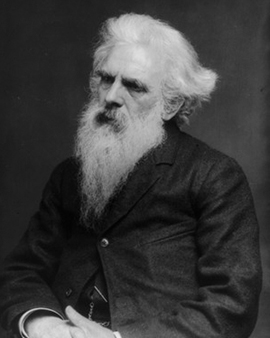The 19th century was the time of many technical innovations. In the 1870s and 1880s, photography underwent an enormous development. Faster and faster camera shutters and increasingly sensitive photographic materials led to great advances. So-called "snapshots" of moving subjects also became possible. Eadweard Muybridge, a native of England, drew aesthetic inspiration from British photographers such as Lewis Caroll, Julia Margaret Cameron and Roger Fenton. He was a photographer, inventor, entrepreneur and entertainer. Muybridge's invention of special techniques to make motion sequences visible through multiple shots was groundbreaking. In the 19th century USA, he succeeded in a unique career as a photographer. Muybridge created a series of photographs of a galloping horse in 1878. He set up 12 cameras along the racetrack and stretched contact wires across the track. The horse's movements triggered the cameras. This was the birth of serial photography. The photographic pioneer thus revealed secrets that had previously been hidden from the human eye. For example, he succeeded for the first time in proving that a horse at a gallop briefly lifts off the ground with all four hooves.
Along with Ottomar Anschütz, Albert Londe and Étienne-Jules Marey, Muybridge is one of the great pioneers of photography. His photographs of people and animals in motion were revolutionary. With his pictures of individual phases of a movement, he founded chronophotography or serial photography. He signed some of his works with his artist name Helios. The tinkerer refined his photographic process more and more. For example, he used a clockwork mechanism with electronic switches as a shutter release, which rotated in certain time sequences. In 1878, Muybridge achieved another groundbreaking invention: the zoopraxiscope, a precursor of the film projector. It is a disc-shaped stroboscope. Using an incandescent lamp, it projects a series of individual images onto a screen. In Palo Alto (California), the inventor presented his first moving images on a screen to an astonished audience. The photographic pioneer thus also did valuable preliminary work for the development of film technology. In one quote, the visionary already foresaw this development: "In the not too distant future, one will [...] record an entire opera, with all the actors' gestures, facial expressions and singing, as well as the accompanying music, and reproduce it with the aid of a device."
With the support of the University of Pennsylvania, Muybridge launched a scientific project on his motion studies in 1883. To do this, he exposed some 100,000 glass plates containing images of, for example, men wrestling, a nude ballet dancer, or elephants. In this way, he documented in detail all possible movements, such as walking, kicking, hopping, sawing. Using a zoopraxiscope, he brought the people and animals to life in their movements. Muybridge was also extremely careful in the selection of his models and attached great importance to graceful posture. Muybridge's books Animals in Motion (1899) and The Human Figure in Motion (1901) are still reprinted today. The movement studies of the photographic pioneer inspired many artists from then until today, for example Edgar Degas, Marcel Duchamp and Francis Bacon.
×





.jpg)
.jpg)
_-_(MeisterDrucke-1012228).jpg)
_-_(MeisterDrucke-1012228).jpg)
.jpg)
.jpg)
.jpg)
.jpg)
.jpg)
.jpg)
.jpg)
.jpg)
.jpg)
.jpg)
.jpg)
.jpg)
.jpg)
.jpg)
.jpg)
.jpg)
_-_(MeisterDrucke-1022737).jpg)
_-_(MeisterDrucke-1022737).jpg)
_-_(MeisterDrucke-975845).jpg)
_-_(MeisterDrucke-975845).jpg)
_-_(MeisterDrucke-954065).jpg)
_-_(MeisterDrucke-954065).jpg)
_-_(MeisterDrucke-953288).jpg)
_-_(MeisterDrucke-953288).jpg)
.jpg)
.jpg)
.jpg)
.jpg)
.jpg)
.jpg)
.jpg)
.jpg)
.jpg)
.jpg)
_-_(MeisterDrucke-954060).jpg)
_-_(MeisterDrucke-954060).jpg)
.jpg)
.jpg)
_-_(MeisterDrucke-954073).jpg)
_-_(MeisterDrucke-954073).jpg)
.jpg)
.jpg)
.jpg)
.jpg)
.jpg)
.jpg)
.jpg)
.jpg)
.jpg)
.jpg)
_-_(MeisterDrucke-1012726).jpg)
_-_(MeisterDrucke-1012726).jpg)
_-_(MeisterDrucke-954076).jpg)
_-_(MeisterDrucke-954076).jpg)
.jpg)
.jpg)
.jpg)
.jpg)
.jpg)
.jpg)
 Vernal Fall 400 Feet Valley of Yosemite - (MeisterDrucke-10734).jpg)
 Vernal Fall 400 Feet Valley of Yosemite - (MeisterDrucke-10734).jpg)
.jpg)
.jpg)
.jpg)
.jpg)
_-_(MeisterDrucke-1022734).jpg)
_-_(MeisterDrucke-1022734).jpg)
.jpg)
.jpg)
.jpg)
.jpg)
.jpg)
.jpg)
_-_(MeisterDrucke-975877).jpg)
_-_(MeisterDrucke-975877).jpg)
.jpg)
.jpg)
.jpg)
.jpg)
.jpg)
.jpg)
.jpg)
.jpg)
.jpg)
.jpg)
.jpg)
.jpg)
.jpg)
.jpg)
.jpg)
.jpg)
.jpg)
.jpg)
_-_(MeisterDrucke-905670).jpg)
_-_(MeisterDrucke-905670).jpg)
 - (MeisterDrucke-69278).jpg)
 - (MeisterDrucke-69278).jpg)
 - (MeisterDrucke-129804).jpg)
 - (MeisterDrucke-129804).jpg)
_-_(MeisterDrucke-900880).jpg)
_-_(MeisterDrucke-900880).jpg)
.jpg)
.jpg)
.jpg)
.jpg)
.jpg)
.jpg)
.jpg)
.jpg)
.jpg)
.jpg)
.jpg)
.jpg)
.jpg)
.jpg)
.jpg)
.jpg)
.jpg)
.jpg)
.jpg)
.jpg)
.jpg)
.jpg)
.jpg)
.jpg)
.jpg)
.jpg)
.jpg)
.jpg)
_-_(MeisterDrucke-975874).jpg)
_-_(MeisterDrucke-975874).jpg)
.jpg)
.jpg)
.jpg)
.jpg)
_-_(MeisterDrucke-954064).jpg)
_-_(MeisterDrucke-954064).jpg)
.jpg)
.jpg)
.jpg)
.jpg)
.jpg)
.jpg)
.jpg)
.jpg)
.jpg)
.jpg)
.jpg)
.jpg)
.jpg)
.jpg)
.jpg)
.jpg)
.jpg)
.jpg)
.jpg)
.jpg)
.jpg)
.jpg)
_-_(MeisterDrucke-993559).jpg)
_-_(MeisterDrucke-993559).jpg)
.jpg)
.jpg)
.jpg)
.jpg)
.jpg)
.jpg)
.jpg)
.jpg)
.jpg)
.jpg)
.jpg)
.jpg)
.jpg)
.jpg)
.jpg)
.jpg)
.jpg)
.jpg)
.jpg)
.jpg)
.jpg)
.jpg)
.jpg)
.jpg)
.jpg)
.jpg)
.jpg)
.jpg)
_-_(MeisterDrucke-900879).jpg)
_-_(MeisterDrucke-900879).jpg)
.jpg)
.jpg)
.jpg)
.jpg)




